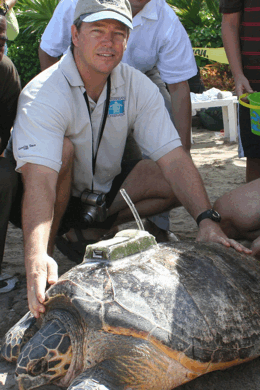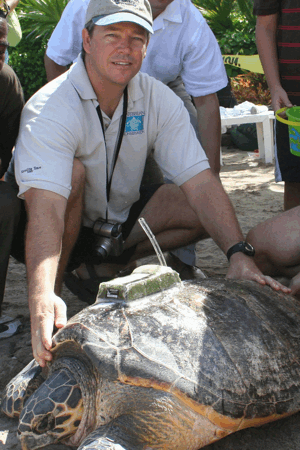Sea Turtle Relocation
Air Date: Week of July 2, 2010

David Godfrey kneels with a sea turtle that has been tagged and will be monitored. (Sea Turtle Conservancy)
It’s turtle nesting season along the Gulf Coast. But with the oil spill still ongoing, scientists fear turtle hatchlings will leave their nests and swim directly into the oily waters. So, conservation groups have devised a strategy to protect the young turtles: move their nests to the Atlantic coast. Host Jeff Young talks with David Godfrey, the executive director of the Sea Turtle Conservancy, about the detailed plan to save this year’s class of sea turtles.
Transcript
YOUNG: From the Jennifer and Ted Stanley studios in Somerville, MA, this is Living on Earth. I’m Jeff Young. The oil in the Gulf of Mexico is hitting the shores of Florida’s panhandle just as an ancient, epic event is unfolding on those beaches. Hundreds of female sea turtles are making their only trip out of the water to nest. Wildlife experts say the turtle hatchlings will likely die if they emerge into the oiled waters. So federal and state officials have made a bold decision to intervene on a massive scale. David Godfrey is executive director of the Sea Turtle Conservancy—a group working on this plan. Mr. Godfrey, welcome back to LOE.
GODFREY: Thank you, nice to be here.
YOUNG: So what’s the plan here, what do you hope to do?
GODFREY: Well in essence what we’re trying to do is save this year’s entire hatchling class of sea turtles form the north coast of Florida from emerging from their nests and swimming out into the gulf in order to meet certain doom because of all the oil that’s in that region.
YOUNG: How do you do it, how do you move all these nests? How many nests are we talking about?
GODFREY: Well, in that part of the Florida coast on average we probably see in the neighborhood of 700 nests, and, of course, each nest has approx 100 eggs in it, so 70,000 or more eggs are going to be moved. A number of things are being done to avoid all of the potential negative impacts of this. And, the things that we’re concerned about, those include potentially tinkering with the sex ratio of the hatchlings developing.
YOUNG: How would it change the sex ratio just by moving the eggs?
GODFREY: Because, the sex of each hatchling is determined by the temperature at which the egg incubates. If you’re moving them all to a particular region, number one you’re changing the temperature they would have incubated at under normal circumstances, and, you’re sort of putting all your eggs in one basket - so that they might all be incubating at the same temperature cause they’re in the same location, thereby creating almost all one sex. So the eggs are going to be allowed to incubate where they were deposited for almost the entire incubation process, which is about 60 days, and at that 50 day mark the nest will be carefully dug up, the eggs removed and placed into a specialized container that is given a layer of sand around the outside directly from the nest, so they’re still within the same sand that they were in before.
And, each one of those individual containers will be carefully transported to a hatchery facility on the east coast of Florida and then as the hatchlings emerge in the container they will immediately be released at the first night fall in a variety of different locations so that there’s not this massive flood of hatchlings all leaving the beach and entering the water at the same location which might tend to attract predators. So we want to avoid that as well.
YOUNG: What might this do to the turtles and their habits of where they end up nesting in the future? Will those hatchlings, will they then return to that beach where they were released, or will they try to get back to the beach on the Gulf Coast?

David Godfrey with a sea turtle that has been tagged and will be monitored. (Sea Turtle Conservancy)
GODFREY: Well, certainly we hope that they will go back to their natal beach, the beach where they are supposed to be nesting on the Gulf Coast, and the protocol that’s being used to move these nests, we hope, is giving them the best chance of doing jut that. It appears that sea turtles can use the earth’s magnetic field to determine where they are at any given moment and use that information to navigate. Well, in order for that to happen, they must have some sort of internal map that tells them where they are, and it’s unknown to science and to biologists exactly when that map is created.
Is it information that’s passed on genetically, so whether you move them or not, the information is there? Or, is it something that occurs during the incubation process? We don’t know exactly, but by leaving them there as long as possible, leaving them within the sand from that beach, we think, gives them the greatest chance of not having their, sort of, navigation cues for that map disturbed in some way.
YOUNG: This sounds like a big gamble, but one where you’re looking at a series of choices ranging from really bad to somewhat less bad.
GODFREY: I think that’s a fair way to look at it. There are potential risks with the relocation, but we think that the plan that’s in place minimizes every one of those risks. It is all so true that our organization is generally very much opposed to relocation turtle nests.
YOUNG: So, ordinarily you’d be opposed to relocating these nests?
GODFREY: That’s right. I mean that simply is not the way to recover sea turtle populations. The real way is to address threats that turtles are facing, whether it’s artificial lights or inappropriate coastal development, we need to address and reduce each one of those threats in order for sea turtles to survive and relocating nests is simply hiding from the real problem. Well, the reality because of this spill is we can’t address that problem any time soon; it’s the greatest calamity for sea turtles that I’ve ever seen. The Sea Turtle Conservancy literally was the first organization in the world formed to protect sea turtles. And, to see all that work and all of our progress jeopardized by this one incident, its heartbreaking and frustrating and we’re just doing what we can at this movement to give them the best chance of survival.
YOUNG: David Godfrey is executive director of the Sea Turtle Conservancy. Thank you.
GODRFEY: Thank you.
Links
Click here for more information on the turtle relocation plan.
Click here for more information on the 2010 hypoxic zone forecast for the Gulf of Mexico.
Click here for more on the link between the oil spill and hypoxia.
Living on Earth wants to hear from you!
Living on Earth
62 Calef Highway, Suite 212
Lee, NH 03861
Telephone: 617-287-4121
E-mail: comments@loe.org
Newsletter [Click here]
Donate to Living on Earth!
Living on Earth is an independent media program and relies entirely on contributions from listeners and institutions supporting public service. Please donate now to preserve an independent environmental voice.
NewsletterLiving on Earth offers a weekly delivery of the show's rundown to your mailbox. Sign up for our newsletter today!
 Sailors For The Sea: Be the change you want to sea.
Sailors For The Sea: Be the change you want to sea.
 The Grantham Foundation for the Protection of the Environment: Committed to protecting and improving the health of the global environment.
The Grantham Foundation for the Protection of the Environment: Committed to protecting and improving the health of the global environment.
 Contribute to Living on Earth and receive, as our gift to you, an archival print of one of Mark Seth Lender's extraordinary wildlife photographs. Follow the link to see Mark's current collection of photographs.
Contribute to Living on Earth and receive, as our gift to you, an archival print of one of Mark Seth Lender's extraordinary wildlife photographs. Follow the link to see Mark's current collection of photographs.
 Buy a signed copy of Mark Seth Lender's book Smeagull the Seagull & support Living on Earth
Buy a signed copy of Mark Seth Lender's book Smeagull the Seagull & support Living on Earth

